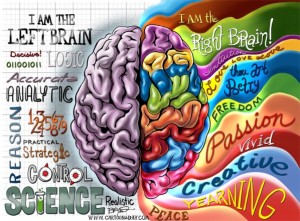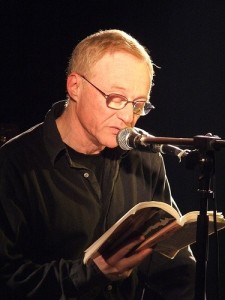 When I was first married, my husband and I used to joke that together we had a complete brain. He was the scientist, a man of logical and rational thinking, and I was the artist, habitual dweller in the land of reverie, seeker of mysteries and mysticism. We identified ourselves in this neatly dualist way, and neuroscience (was the discipline even called that then?) seemed to reflect our conclusions.
When I was first married, my husband and I used to joke that together we had a complete brain. He was the scientist, a man of logical and rational thinking, and I was the artist, habitual dweller in the land of reverie, seeker of mysteries and mysticism. We identified ourselves in this neatly dualist way, and neuroscience (was the discipline even called that then?) seemed to reflect our conclusions.
This was at a time just before Drawing on the Right Side of the Brain (1979) became a massive bestseller. That book popularized the idea that our brains were divided into right and left hemispheres and that each half was responsible for different, opposite functions.
The right hemisphere was thought to be responsible for intuitive, impressionistic, dreamy, “feminine” functions while the left hemisphere was thought to be the more rational, here-and-now, “masculine” side of the brain.
 Even back then, I was aware my husband and I understood the world differently: we perceived and evaluated situations differently, used different models to solve problems, and arrived at different conclusions and solutions. He liked facts and proof; I liked suppositions and questioned accepted knowledge. Cause and effect offered him clear answers. Cause and effect bored me. I liked to spin off possibilities. He liked B to always follow A. I liked to see what would happen if D followed A and B disappeared completely. The majority of people we knew shared my husband’s preferences (and this, I think, is true for most of the West). As you can imagine, some of our worst arguments resulted from the differences in our supposed hard wiring and apprehension of truth.
Even back then, I was aware my husband and I understood the world differently: we perceived and evaluated situations differently, used different models to solve problems, and arrived at different conclusions and solutions. He liked facts and proof; I liked suppositions and questioned accepted knowledge. Cause and effect offered him clear answers. Cause and effect bored me. I liked to spin off possibilities. He liked B to always follow A. I liked to see what would happen if D followed A and B disappeared completely. The majority of people we knew shared my husband’s preferences (and this, I think, is true for most of the West). As you can imagine, some of our worst arguments resulted from the differences in our supposed hard wiring and apprehension of truth.
Writers have a special interest in how minds work. As a child, my own mind seemed at odds with my classmates. Friendship wasn’t the problem: I was highly social and well liked, but I often found it difficult to express myself in the classroom. Words were slippery and never quite adequate to what I had to say. Not all people who end up being creative writers fit the description of a highly fluent, highly verbal young wordsmith. Some of us were mute observers, unnoticed by English teachers or others who might have encouraged us toward expression. This isn’t the usual backstory for a writer, which is in part why I’m telling it—in case there are others reading this who recognize themselves here.
Language itself could be problematic. Like many writers, I was a voracious reader, but reading out loud in a reading group was agony. The letters disappeared in front of my eyes. Trying to translate the images I saw in my head into words, sentences, thoughts, was a confusion all its own. This tendency toward inwardness and understanding the world through a flow of images was surely the first evidence of my nascent poet self—the little girl who saw/felt/understood more than her years and was desperate to find words for it—but how could she/I have known that then?
 How could I have known that decades later, Robert Bly would write a book praising intuitive, associative thought. Leaping Poetry gave birth to a new idiom in American poetry that later developed into The Deep Image School, a reaction to the Modernist aesthetic of highly crafted, rational poetry inspired by T.S. Eliot and company. Bly translated and popularized previously unheard of poets like Neruda, Lorca, and Transtromer, writers who believed the unconscious mind was a source of great energy for writers. He suggested that linked or associated images embodied irrational knowledge and wisdom our conscious minds could not otherwise access. Much like my own associative mind, his proposed juxtaposition of incongruous images (this is essentially what metaphor is) generated a poetry of startling insights. Try to unpack a poem by Neruda or Vallejo and they go dry and lifeless. (Really, don’t try to explain any poem. Just let it sing to you.) Poems resist paraphrasing, and especially in associatively imagined poems, the linear requirements of grammar are absolved. We are in holy territory, in the presence of shamanic chants.
How could I have known that decades later, Robert Bly would write a book praising intuitive, associative thought. Leaping Poetry gave birth to a new idiom in American poetry that later developed into The Deep Image School, a reaction to the Modernist aesthetic of highly crafted, rational poetry inspired by T.S. Eliot and company. Bly translated and popularized previously unheard of poets like Neruda, Lorca, and Transtromer, writers who believed the unconscious mind was a source of great energy for writers. He suggested that linked or associated images embodied irrational knowledge and wisdom our conscious minds could not otherwise access. Much like my own associative mind, his proposed juxtaposition of incongruous images (this is essentially what metaphor is) generated a poetry of startling insights. Try to unpack a poem by Neruda or Vallejo and they go dry and lifeless. (Really, don’t try to explain any poem. Just let it sing to you.) Poems resist paraphrasing, and especially in associatively imagined poems, the linear requirements of grammar are absolved. We are in holy territory, in the presence of shamanic chants.
Okay, I know. The truth is: any creative endeavor requires the use of our complete brain, the parts that order reality as well as the regions of emotion, memory, ancestral wisdom. The ubiquitous yin/yang symbol above every yoga store conveys this opposition and interdependence that comprise the whole. The circle (brain) contains the opposites.
 As it turns out, the neat old models of left brain/right brain weren’t quite accurate. According to more recent science the two brain hemispheres have differences but don’t function as independently of each other as previously thought. They differ in size and shape and in the number of neurons and neural size. They differ in their sensitivity to hormones and pharmaceutical agents and other ways as well, but the most significant difference lies in the type of attention they give the world. The hemispheres house different sets of values and priorities.As he describes in The Master and his Emissary: The Divided Brain and the Making of the Western World, Iain McGilchrist, a research psychiatrist, believes that over time “there has been a relentless growth of self-consciousness (left brain) and a shift away from a reliance on right brain values (interconnectedness).”
As it turns out, the neat old models of left brain/right brain weren’t quite accurate. According to more recent science the two brain hemispheres have differences but don’t function as independently of each other as previously thought. They differ in size and shape and in the number of neurons and neural size. They differ in their sensitivity to hormones and pharmaceutical agents and other ways as well, but the most significant difference lies in the type of attention they give the world. The hemispheres house different sets of values and priorities.As he describes in The Master and his Emissary: The Divided Brain and the Making of the Western World, Iain McGilchrist, a research psychiatrist, believes that over time “there has been a relentless growth of self-consciousness (left brain) and a shift away from a reliance on right brain values (interconnectedness).”
 Empathy might well be another word for interconnectedness. Empathy is the ability to put oneself in another’s shoes, and an essential ingredient in creating fiction. In Writing in the Dark, David Grossman writes: “I write. I feel the many possibilities that exist in any human situation.” He speaks about the necessity of writers to examine each character from many points of view. “The role an author plays for his characters: with all his might, with all his talent and empathy, he must exist in their space… He must be completely attentive to all their needs, both the spiritual and the corporeal. He must devote himself to them. Body and soul.” Here, finally, is where art and science meet, where feeling and thinking are not oppositional ways of understanding and judging our universe, but systolic and diastolic complementary ways of knowing.
Empathy might well be another word for interconnectedness. Empathy is the ability to put oneself in another’s shoes, and an essential ingredient in creating fiction. In Writing in the Dark, David Grossman writes: “I write. I feel the many possibilities that exist in any human situation.” He speaks about the necessity of writers to examine each character from many points of view. “The role an author plays for his characters: with all his might, with all his talent and empathy, he must exist in their space… He must be completely attentive to all their needs, both the spiritual and the corporeal. He must devote himself to them. Body and soul.” Here, finally, is where art and science meet, where feeling and thinking are not oppositional ways of understanding and judging our universe, but systolic and diastolic complementary ways of knowing.